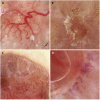Clinical, Dermoscopic and Histopathological Evaluation of Basal Cell Carcinoma
- PMID: 36892362
- PMCID: PMC9946123
- DOI: 10.5826/dpc.1301a4
Clinical, Dermoscopic and Histopathological Evaluation of Basal Cell Carcinoma
Abstract
Introduction: Dermoscopy aids in identifying histopathological subtypes and the presence of clinically undetectable pigmentation in basal cell carcinoma (BCC).
Objectives: To investigate the dermoscopic features of BCC subtypes and better understand non-classical dermoscopic patterns.
Methods: Clinical and histopathological findings were recorded by a dermatologist who was blinded to the dermoscopic images. Dermoscopic images were interpreted by two independent dermatologists blinded to the patients' clinical and histopathologic diagnosis. Agreement between the two evaluators and with histopathological findings was evaluated using Cohen's kappa coefficient analysis.
Results: The study included a total of 96 BBC patients with 6 histopathologic variants: nodular (n=48, 50%), infiltrative (n=14, 14.6%), mixed (n=11, 11.5%), superficial (n=10, 10.4%), basosquamous (n=10, 10.4%), and micronodular (n=3, 3.1%). Clinical and dermoscopic diagnosis of pigmented BCC showed high agreement with histopathological diagnosis. The most common dermoscopic findings according to subtype were as follows: nodular BCC: shiny white-red structureless background (85.4%), white structureless areas (75%), and arborizing vessels (70.7%); infiltrative BCC: shiny white-red structureless background (92.9%), white structureless areas (78.6%), arborizing vessels (71.4%); mixed BCC: shiny white-red structureless background (72.7%), white structureless areas (54.4%), and short fine telangiectasias (54.4%); superficial BCC: shiny white-red structureless background (100%), short fine telangiectasias (70%); basosquamous BCC: shiny white-red structureless background (100%), white structureless areas (80%), keratin masses (80%); micronodular BCC: short fine telangiectasias (100%).
Conclusions: In this study, arborizing vessels were the most common classical dermoscopic feature of BCC, while shiny white-red structureless background and white structureless areas were the most frequent non-classical dermoscopic features.
Conflict of interest statement
Figures





References
LinkOut - more resources
Full Text Sources
